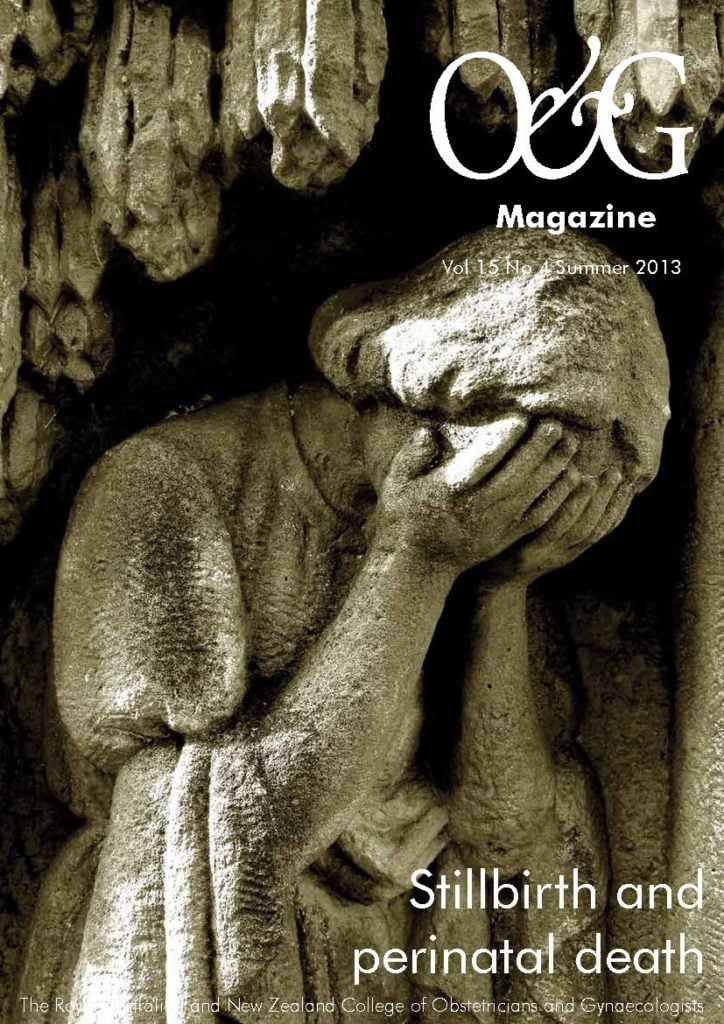How should we manage this common clinical conundrum?
Most women report initially feeling fetal movements at some time between 18 and 20 weeks gestation and movements are typically experienced earlier in multiparous women compared with women in a first pregnancy. ‘Movements’ have been defined as any discrete kick, flutter, swish or roll1, and the first perception of movement has traditionally been called ‘quickening’. These fetal movements should continue to be felt following the initial perception of activity and, while the type and nature of movements may change, there is no evidence supporting a reduction of movements as the pregnancy advances.2
Fetal movements are reassuring to women and, conversely, a reduction in fetal movements commonly is a cause for concern. Reduced or absent movements have been associated with a poor perinatal outcome3,4 with a majority of women who have had a stillbirth describing reduced fetal movements prior to the diagnosis.5 Studies from Norway have shown that an inappropriate clinical response to reduced fetal movements was a common contributing factor in stillbirths.6
Normal fetal movements
Fetal activity indicates a healthy integrity of the fetal central nervous and musculoskeletal systems. A normal healthy fetus will demonstrate periods of both activity and sleep, with fetal movement usually being absent during the sleep phase. It is rare for a sleep phase to exceed 90 minutes in a healthy fetus.
Various methods for counting movements have been proposed, including the perception of at least ten movements over 12 hours of normal maternal activity and the perception of at least ten movements over two hours when the mother is resting and focused on counting. The most vigorously tested definition of reduced fetal movements comes from Moore and colleagues7, who recommended the definition: ‘Less than ten movements within two hours when the fetus is active.’ This is also the definition currently used by the American Congress of Obstetricians and Gynecologists (ACOG).
Everybody providing maternity care needs to confront the question: should fetal movements routinely be counted? A recent Cochrane review involving a total of 71 370 women across four trials concluded there was insufficient evidence to support formal fetal movement counting for all women.8 As mentioned previously, there is a broad range of fetal activity patterns that can be considered ‘normal’, and the practice of asking all women routinely count movements can be associated with an increase in maternal anxiety.9 Despite widespread advice to the contrary, there is no evidence to support the advice that a fetus will respond with movements following the mother eating something sweet or drinking a cold drink.
Clinical assessment of reduced fetal movements
The initial aim of those responding to women reporting reduced fetal movements should be to exclude a fetal death and then, subsequently, to exclude fetal comprise and identify pregnancies at risk of a poor outcome. With this in mind, it is important to be aware of the association between reduced movements and fetal growth restriction, placental insufficiency and congenital malformations. Hence, when assessing any woman presenting with reduced movements, a relevant history needs to be taken. This should address any risk factors for growth restriction or placental insufficiency, including previous pregnancy complications and outcomes, and general maternal health. The history should include the duration of the reduction in movements, whether there have been any periods of absent fetal movement and whether this is the first episode the woman has experienced.
A hand-held Doppler can confirm the presence of a fetal heart rate immediately and, once fetal viability has been confirmed and the history has confirmed a reduction in fetal movement, a cardiotocogram (CTG) should be performed to exclude fetal compromise if the pregnancy is over 28 weeks gestation. A normal CTG indicates a functioning fetal autonomic nervous system and usually a healthy fetus.
There is currently no evidence to support a policy of ultrasound assessment for all women presenting with reduced fetal movements, but ultrasound should be performed if the perception of reduced movements continues despite a reassuring CTG tracing, or if there are other concerns about fetal growth restriction, for example, from past pregnancy history or where the fundal height is small for dates. If an ultrasound is to be performed, it should ideally be done within 24 hours of the presentation and should include an assessment of fetal size, amniotic fluid volume and fetal morphology if not already done. There may also be a role for biophysical profile (BPP) scoring to be performed in some cases of reduced fetal movements. The exact place of a BPP is uncertain and the Cochrane review did not support the use of BPP as a test for fetal wellbeing in high-risk pregnancies10 although there is evidence suggesting fetal demise is rare in women with a normal BPP.11
The possibility of a feto-maternal haemorrhage should always be considered, as occasionally reduced fetal movements may be the only indicator of the condition. A sinusoidal pattern on the CTG tracing is a diagnostic, but late, finding and may not be present in all cases, hence a test for evidence of a materno-fetal haemorrhage such as a Kleihauer-Betke test should be considered.
Management of reports of reduced fetal movements
Concerns about reduced fetal movement are common and most women who have a single episode of reduced fetal movements will have an uncomplicated pregnancy and can be given reassurance following assessment of the fetus. At this point, there are still no data to suggest formal kick charts are of any benefit in this scenario. However, if a woman presents with recurrent episodes of reduced fetal movements, she should be carefully reviewed and an ultrasound performed to exclude fetal growth restriction and any other complicating factor. These women may be at an increased risk of a poor perinatal outcome and the need to deliver should be considered even if the CTG and ultrasound assessments are normal, provided that she is at or near term.
If a woman presents with reduced fetal movements under 24 weeks gestation, then the presence of a fetal heart should be confirmed with a Doppler device, as it should between 24 and 28 weeks gestation, although an ultrasound should also be considered in this group, as early-onset placental insufficiency can occur at this gestation.
Finally, it is important to document the details of any assessment and management of women with reduced movements and to also record advice about follow up and when and where to present if further episodes of reduced fetal movements were to occur.
References
- Neldam S. Fetal movements as an indicator of fetal well-being. Dan Med Bull 1983; 30: 274-8.
- Tveit JV, Saastad E, Stray-Pederson B, et al. Reduction of late stillbirth with the introduction of fetal movement information and guidelines – a clinical quality improvement. BMC Pregnancy Childbirth 2009; 9:32
- Grant A, Elbourne D, Valentin L, Alexander S. Routine formal fetal movement counting and risk of antepartum late death in normally formed singletons. Lancet 1989; 2: 345-9.
- Harrington K, Thompson O, Jordan L, Page J, Carpenter RG, Campbell S. Obstetric outcome in women who present with a reduction in fetal movements in the third trimester of pregnancy. J Perinat Med 1998; 26: 77-82.
- Efkarpidis S, Alexopoulos E, Kean L, Liu D, Fay T. Case-control study of factors associated with intrauterine fetal deaths. MedGenMed 2004; 6: 53.
- Saastad E, Vangen S, Froen JE. Suboptimal care in stillbirths – a retrospective audit study. Acta Obstet Gynecol Scand 2007; 86: 444-50.
- Moore TR, Piacquadio K. A prospective evaluation of fetal movement screening to reduce the incidence of antepartum fetal death. Am J Obstet Gynecol 1989; 160: 1075-80.
- Mangesi L, Hofmeyr GJ. Fetal movement counting for assessment of fetal wellbeing. Cochrane Database Syst Rev 2007:CD004909.
- Froen JE, Tveit JV, Saastad E, Bordahl PE, Stray-Pederson B, Heazel AE et al. Management of decreased fetal movements. Semin Perinatol 2008; 32: 307-11.
- Lalor JG, Fawole B, Alfirevic Z, Devane D. Biophysical profile for fetal assessment in high risk pregnancies. Cochrane Database Syst Rev 2008: CD000038.
- Dayal AK, Manning FA, Berck DJ, Mussalli GM, Avila C, Harman CR et al. Fetal death after normal biophysical profile score; An eighteen year experience. Am J Obstet Gynecol 1999; 181: 1231-6.






Leave a Reply